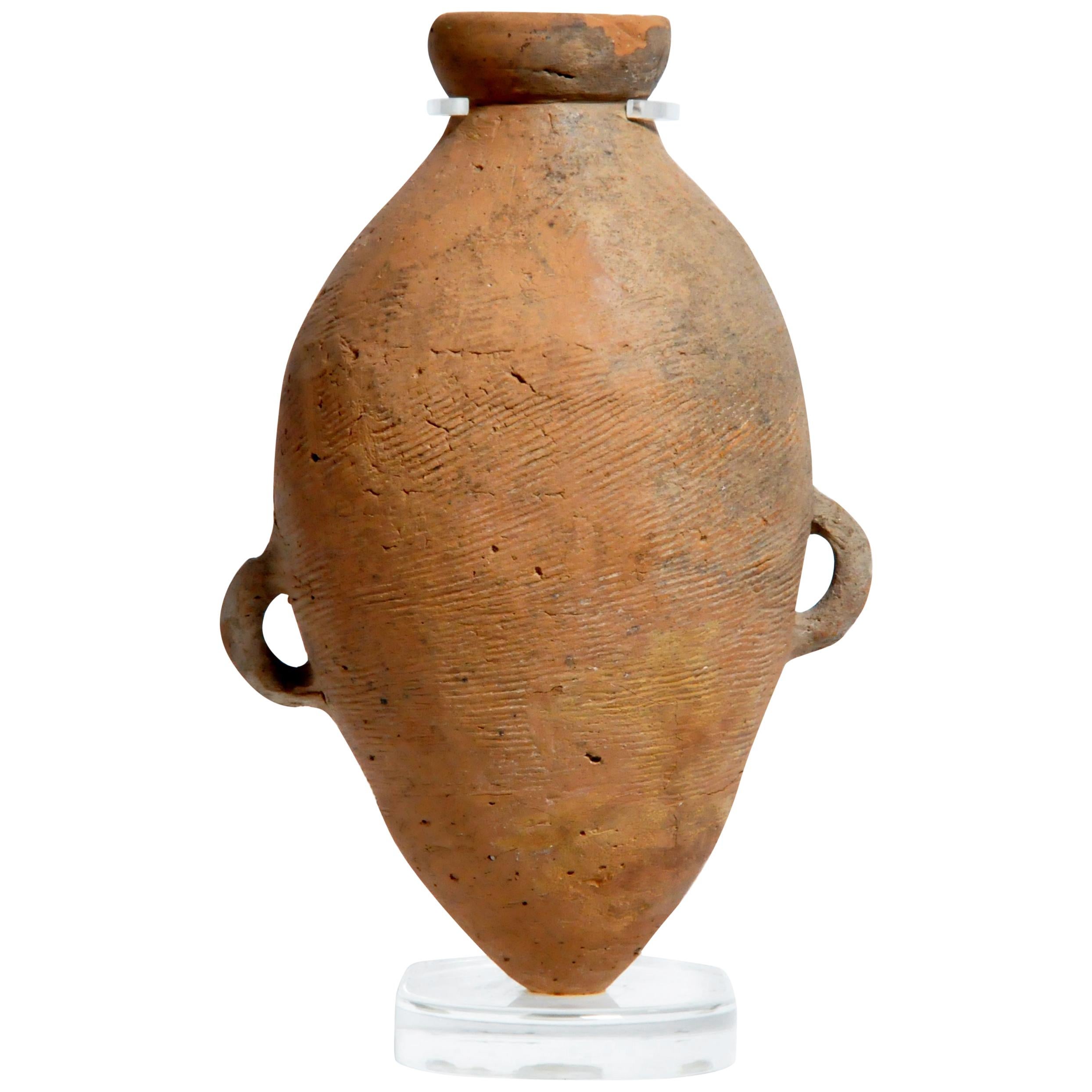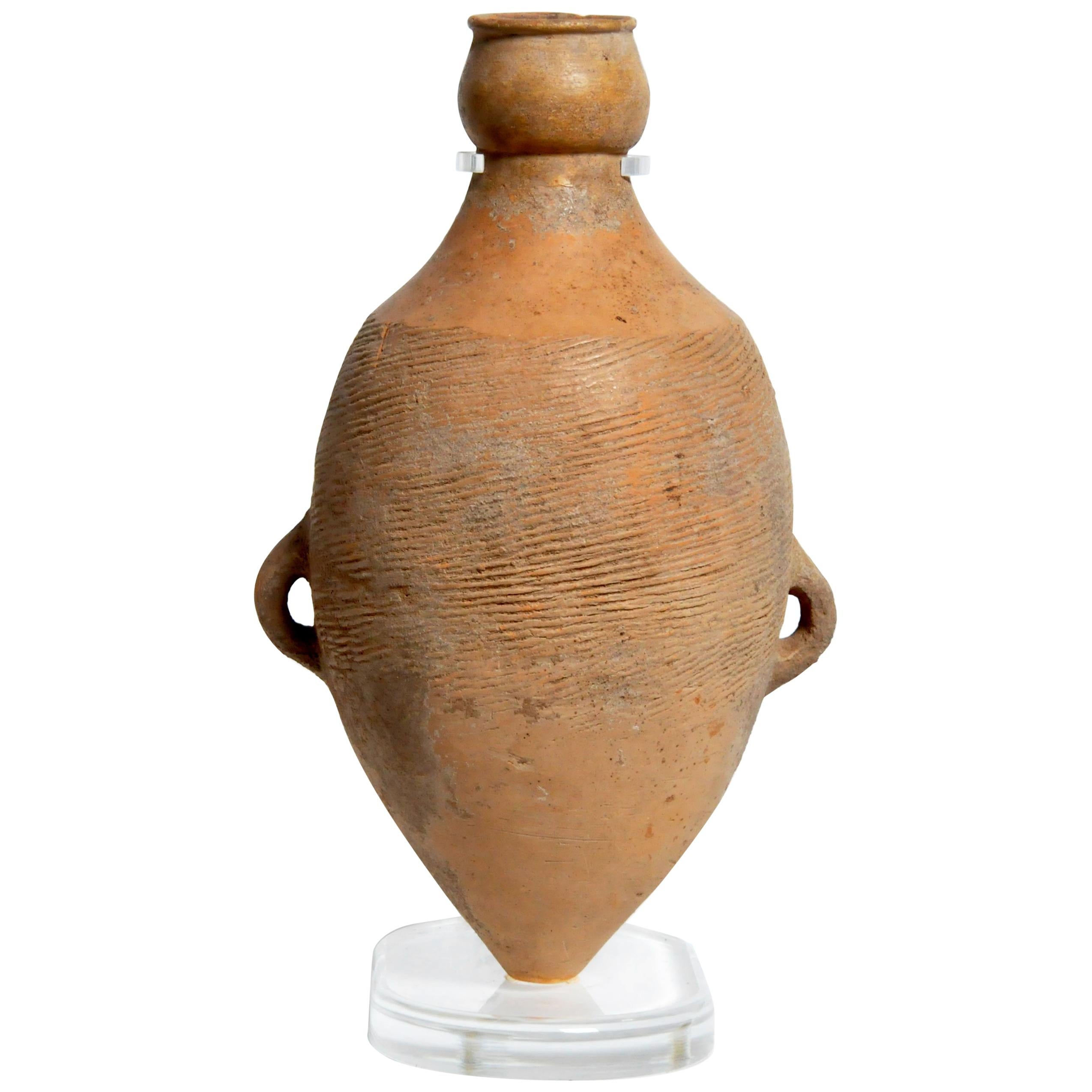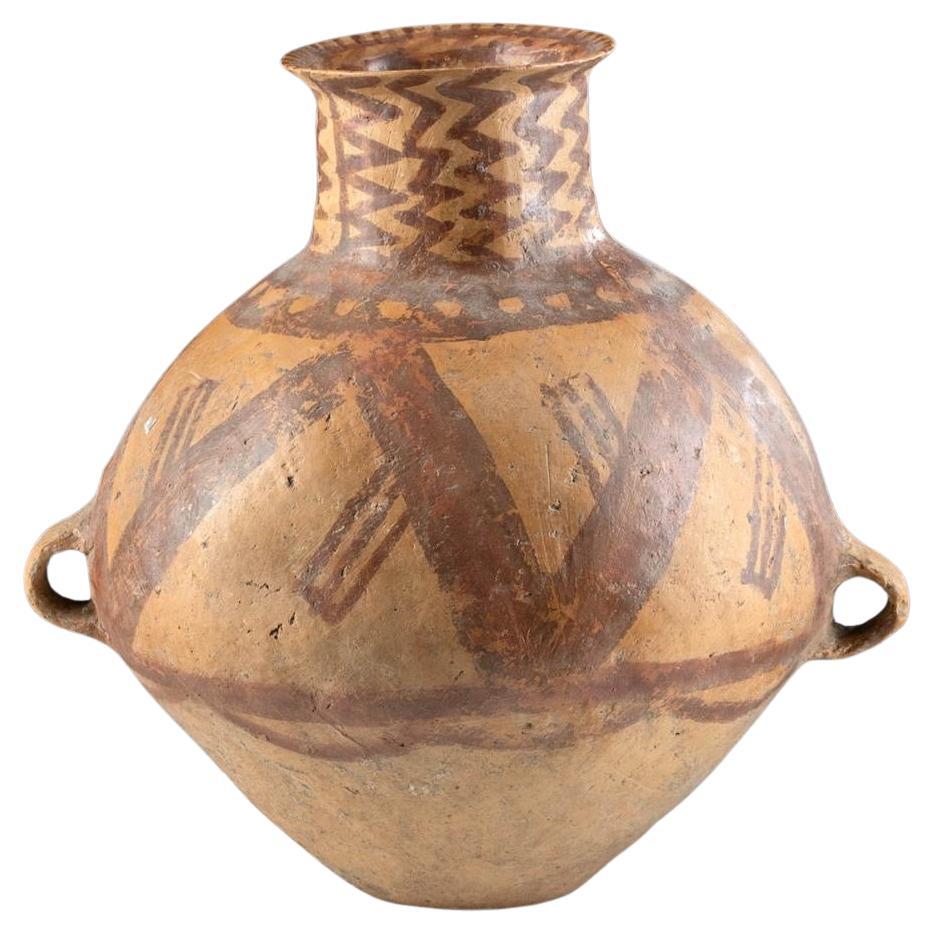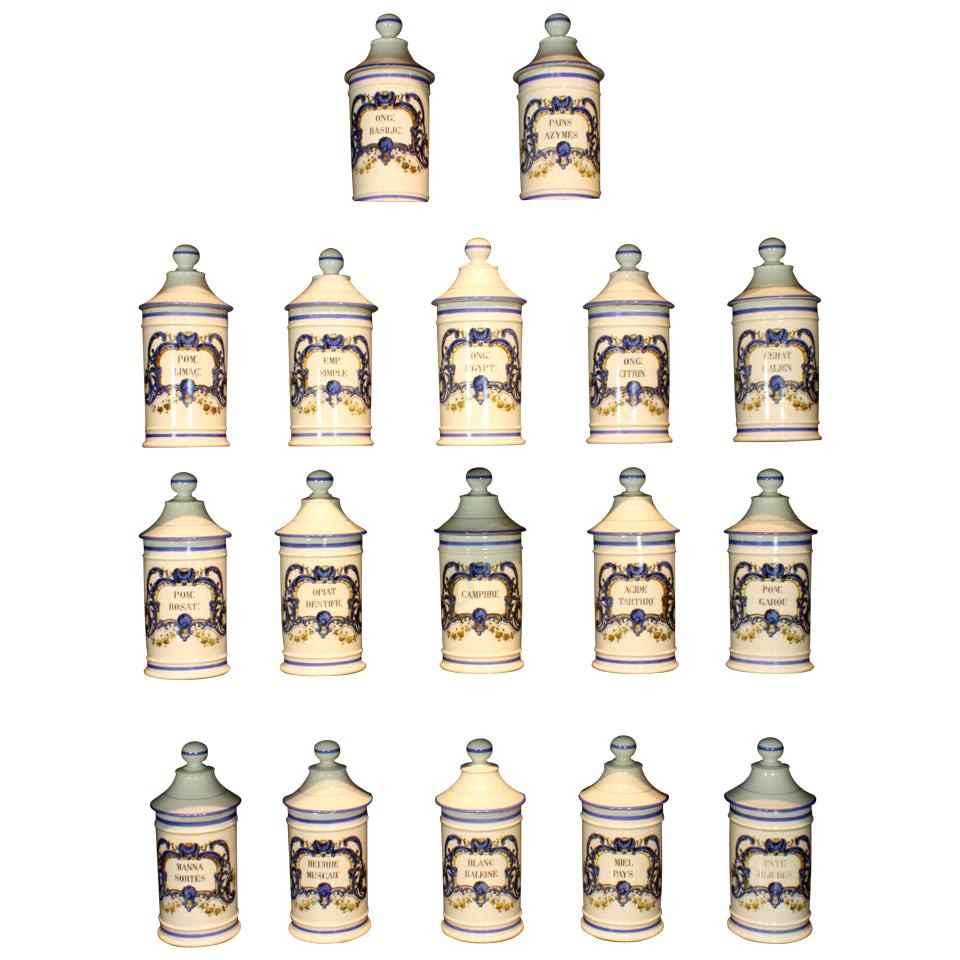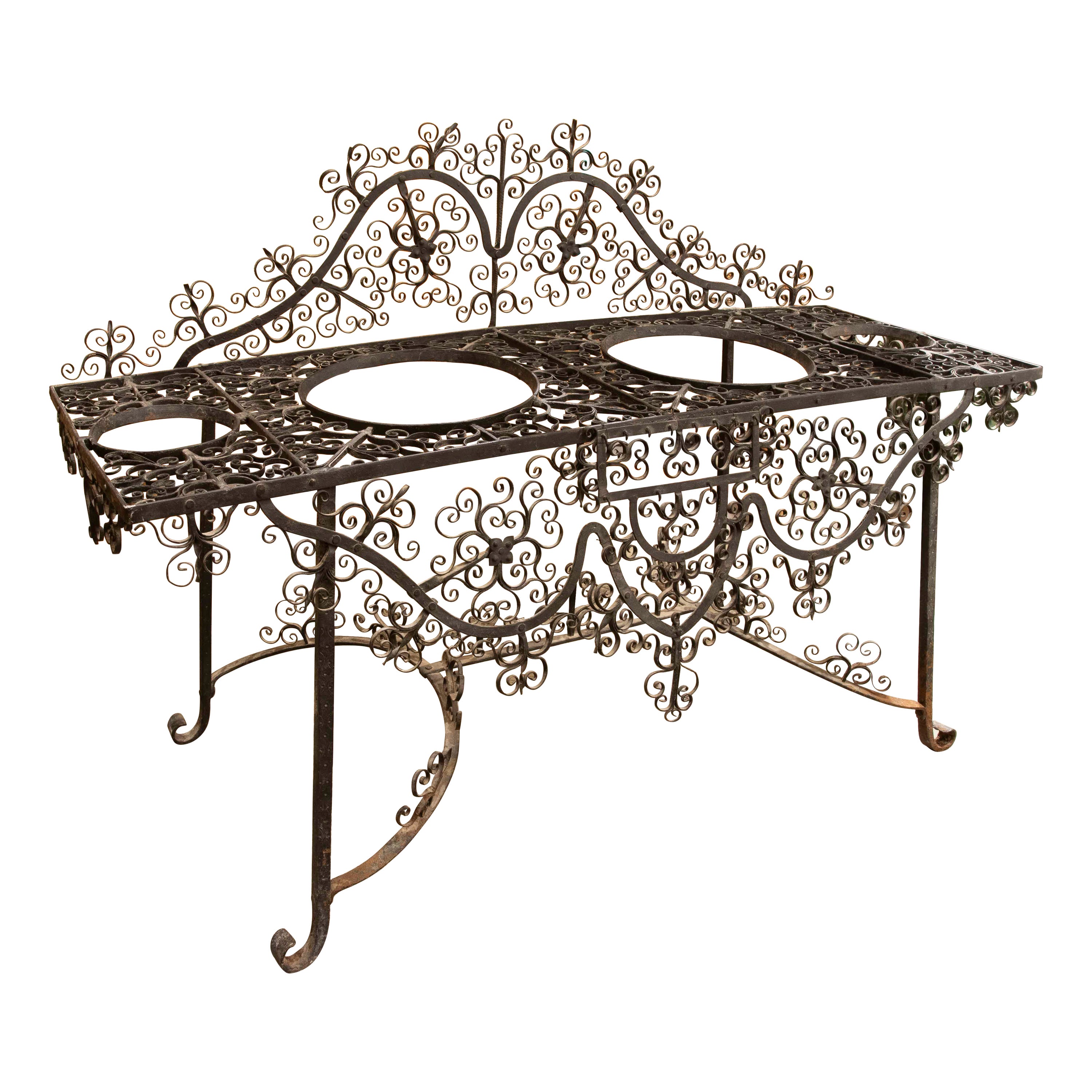Items Similar to Jar with Painted Decoration of "Frog" Pattern, Neolithic Period
Want more images or videos?
Request additional images or videos from the seller
1 of 12
Jar with Painted Decoration of "Frog" Pattern, Neolithic Period
About the Item
Large and small two-handled jars, pitchers, bowls, and beakers are the most common forms produced during the Machang phase of the Majiayao (or Gansu Yangshao) culture. The decorative motifs on Machang-period wares are primarily geometric, featuring curvilinear patterns, cross-hatching, and a variety of shapes such as lozenges, triangles, circles, and squares in endless combinations. One of the most distinctive images in the Machang vocabulary is the zoomorphic figure found in the center of these jars. This figure features a long torso with four limbs bent at the center, topped with a small head. Feathers or similar tufting are present at the end of the upper limbs and at the joints of all four appendages. The interpretation of these enigmatic motifs varies: some suggest they are abstract representations of natural creatures like frogs, while others propose that they symbolize either the costume worn by a shaman or the transformation he undergoes during rituals.
Period: Neolithic period, Presumablt Majiayao culture (ca. 3300–2050 BCE)
Medium : Earthenware with pigment
Type : Jar
Provenance : Acquired in late 1990s from Hongkong
Reference :
1) The MET - Accession Number: 1992.165.8
2) Sotheby's London 8 December 2022 - The Personal Collection of the late Sir Joseph Hotung - Lot 109
(Price realised : 3,528 GBP / Type : Closely related)
* Neolithic pottery
Neolithic pottery from China, dating approximately between 10,000 BCE to 2,000 BCE, is a significant cultural artifact that reflects the rich culture and advanced technology of the region during this era. The pottery found across various regions of China displays unique styles and techniques, indicating a diverse and sophisticated cultural landscape.
During the Neolithic period, pottery in China was predominantly used for agricultural purposes, including storage containers, cooking vessels, and dining utensils. It was common for Neolithic Chinese cultures to decorate pottery with intricate patterns or colors, often reflecting the religious beliefs or life philosophies of the time. For instance, pottery from the Hemudu culture in the Yangtze River basin is known for its black and red patterns, while the Yangshao culture in the Yellow River basin is characterized by its fine linear designs.
The shapes and sizes of Neolithic Chinese pottery varied greatly, influenced by the climate, geography, and natural resources of each region. Some areas prioritized large and heavy storage containers, while others required smaller and more portable bowls for convenience.
Archaeological excavations of this pottery have been crucial in understanding the transition to settled life, the advancement of agricultural techniques, and the complexity of early societies in China. The production techniques and stylistic decorations of the pottery evolved over time, and these variations provide invaluable data for studying the development and cultural exchanges of ancient Chinese societies.
- Dimensions:Height: 13.78 in (35 cm)Diameter: 13.39 in (34 cm)
- Materials and Techniques:
- Place of Origin:
- Period:
- Date of Manufacture:3300–2050 BCE
- Condition:Minor fading.
- Seller Location:seoul, KR
- Reference Number:1stDibs: LU9577239782052
About the Seller
New to 1stDibs
Joined in the past six months.
4.5
Vetted Seller
These experienced sellers undergo a comprehensive evaluation by our team of in-house experts.
Established in 1999
1stDibs seller since 2023
Typical response time: <1 hour
- ShippingRetrieving quote...Ships From: seoul, Korea South
- Return PolicyA return for this item may be initiated within 10 days of delivery.
More From This SellerView All
- Pottery jar, Neolithic period, Majiayao cultureLocated in seoul, KRLarge and small two-handled jars, pitchers, bowls, and beakers are the most common forms produced during the Machang phase of the Majiayao (or Gansu Yangshao) culture. The decorative...Category
Antique 15th Century and Earlier Chinese Antiquities
MaterialsPottery
- Chinese Porcelain Ginger Jar, Qing Dynasty Yongzheng PeriodLocated in seoul, KRA Chinese porcelain ginger jar, Yongzheng period, painted in underglaze blue with lotus blooms and shou(水, meaning 'Water') characters beneath a ruyi border, underglaze blue double r...Category
Antique 1720s Chinese Chinese Export Jars
MaterialsCeramic, Porcelain
- Neolithic Pottery Amphora, 3rd-2nd Millenium BCLocated in seoul, KRThis Neolithic pottery presents a robust form with a rounded bottom, tapering to a wide, open top. It features two small loop handles symmetrically placed on either side. The vessel'...Category
Antique 15th Century and Earlier Chinese Jars
MaterialsEarthenware, Pottery
- Cocoon-shaped earthenware jar with cloud-scroll design, West Han DynastyLocated in seoul, KRThis yellow handsome jar with excellent condition would have served as a mortuary object (mingqi), placed in a tomb as a substitute for the more valuable bronze and lacquer vessels u...Category
Antique 15th Century and Earlier Chinese Han Jars
MaterialsStoneware
- A large yellow ground famille rose vase, Late Qing Period.Located in seoul, KRPorcelain painted in overglaze polychrome enamels, yellow ground. Period: Qing Dynasty(19th century) Type: Vase Medium: Famille rose Size : 58cm(Height) x 19.5cm(Mouth Diameter) Con...Category
Antique 19th Century Chinese Qing Vases
MaterialsCeramic
- Chinese Jardinière Famille Rose Porcelain in Six Colors, Qing PeriodLocated in seoul, KRA Chinese jardinière rarely in six colors, hexagonal, China, presumably 19th century. Period: Qing Dynasty Type: Jardinière Medium: Famille rose Size : 17 cm(Height) x 24cm(Mouth Di...Category
Antique 19th Century Chinese Qing Planters, Cachepots and Jardinières
MaterialsCeramic, Porcelain
You May Also Like
- Neolithic Jar on StandLocated in Chicago, ILThis Neolithic jar originates from China 3500 BC and these funerary jars were placed in tombs and intended for use in the afterlife.Category
Antique 15th Century and Earlier Chinese Jars
MaterialsTerracotta
- Neolithic Jar on StandLocated in Chicago, ILThis Neolithic jar originates from China 3500 BC and these funerary jars were placed in tombs and intended for use in the afterlife.Category
Antique 15th Century and Earlier Chinese Jars
MaterialsTerracotta
- Chinese Neolithic Majiayao Bichrome Jar w/ HandlesLocated in Bonita Springs, FLEast Asia, China, Neolithic Period, Majiayao culture, ca. 3300 to 2000 BCE. An impressive pottery jar of a voluminous form hand-painted with abstract linear and geometric designs. Ve...Category
Antique 15th Century and Earlier Asian Vases
MaterialsPottery
- Set of Six '6' French Porcelain Apothecary Jars with Painted Decoration and MarkLocated in Pembroke, MAA beautiful and rare set of six (6) high-quality hand painted French apothecary jars, each with a different label, painted in a Régence style in blue and yellow, with separate domed ...Category
Antique 19th Century French Belle Époque Jars
MaterialsPorcelain
- 1970s Black Painted Iron Base for Jars with Scroll DecorationLocated in Marbella, ES1970s Black Painted Iron Base for Jars with Scroll DecorationCategory
Late 20th Century Spanish Vases
MaterialsIron
- Meiji Period Japanese Cloisonné Covered Jar with Geometric Patterns Attributed tLocated in New York, NYAn antique Japanese copper with gold wire cloisonne enamel design. Late Meiji period, before 1912. Beige body with a floral oranement. Front panel depicting storks against the turquo...Category
Antique Late 19th Century Japanese Meiji Jars
MaterialsEnamel, Copper
Recently Viewed
View AllMore Ways To Browse
Lozenge Pattern Furniture
Antique Triangle
Jointed Figure
Agriculture Antique
Antique Agricultural
Chinese Landscape Vase
Black Figure Vase
Yellow Vessel With Handles
Antique Chinese Vase Shapes
Antique Kitchen Containers
Large Chinese Jar
Ritual Vessel
Antique Pottery Prices
Ancient Jar
Pottery Cross
China Black Pottery
Chinese Black Pottery
Vase With Circle On It
